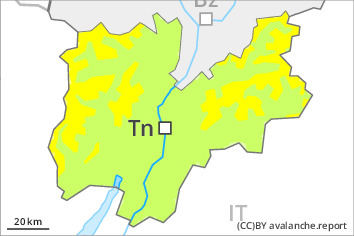
Danger level
 | 2200m |
|  |
|  | ||||
|  |
|  |

Old wind slabs require caution.
Weak layers in the old snowpack can be released in some places by individual winter sport participants. The avalanche prone locations are to be found in all aspects above the tree line. The avalanche prone locations are barely recognisable, even to the trained eye. In isolated cases avalanches are medium-sized. At transitions from a shallow to a deep snowpack, when entering gullies and bowls for example the likelihood of avalanches being released is greater.
The somewhat older wind slabs can still be released in some cases in all aspects above the tree line.
Backcountry touring and other off-piste activities call for experience in the assessment of avalanche danger.
Snowpack
dp.1: deep persistent weak layer
Faceted weak layers exist in the snowpack, especially on shady slopes above approximately 2200 m, as well as on sunny slopes above approximately 2500 m.
The somewhat older wind slabs are lying on unfavourable layers in particular on wind-protected shady slopes.
Especially at low and intermediate altitudes only a small amount of snow is lying for the time of year. Above the tree line snow depths vary greatly, depending on the infuence of the wind. On sunny slopes the snowpack will freeze during the clear night and form a strong crust, especially at low and intermediate altitudes.
Tendency
As a consequence of warming the avalanche prone locations will become more prevalent on Sunday.

